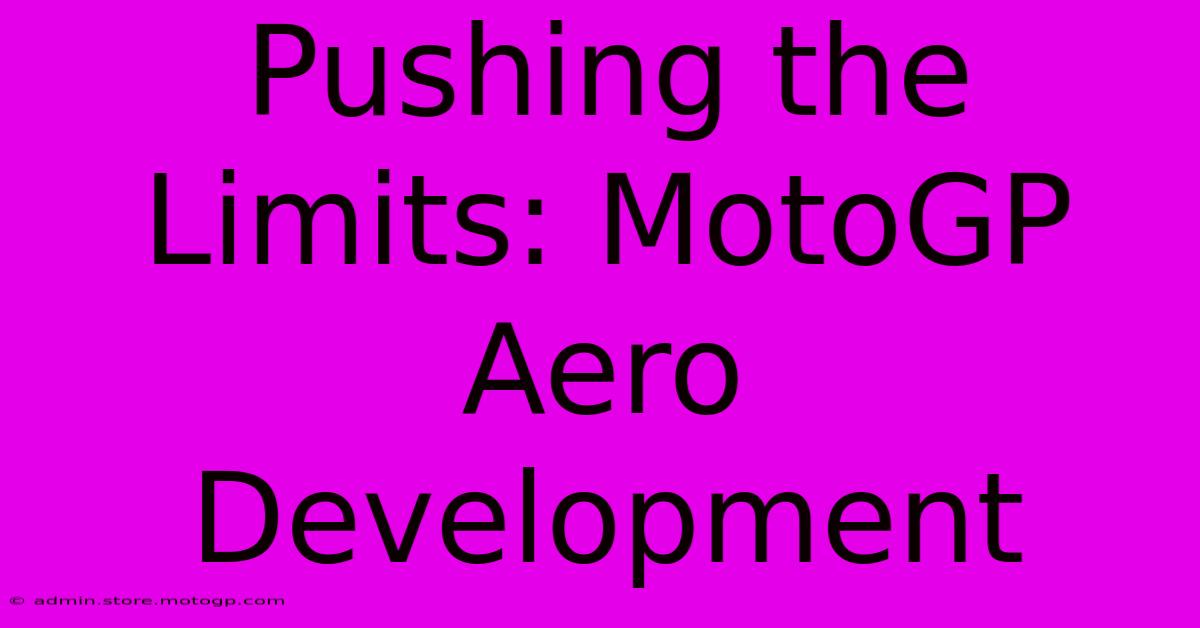Pushing The Limits: MotoGP Aero Development

Table of Contents
Pushing the Limits: MotoGP Aero Development
The roar of the engines, the blur of speed, the breathtaking lean angles – MotoGP is a spectacle of skill and technology. But beyond the rider's prowess lies a crucial element driving performance: aerodynamic development. This relentless pursuit of aerodynamic advantage pushes the boundaries of engineering, constantly refining designs to extract every ounce of speed and stability from these incredible machines.
The Science of Speed: Understanding MotoGP Aerodynamics
MotoGP bikes aren't just fast; they're meticulously engineered to slice through the air with minimal resistance. This involves a complex interplay of several aerodynamic principles:
Downforce Generation:
- Wings and Winglets: These are perhaps the most visually striking aerodynamic features. Strategically placed wings and winglets generate downforce, pressing the bike to the track at high speeds. This improves stability, allowing riders to maintain higher cornering speeds and brake later. The design, angle, and placement of these components are constantly tweaked for optimal performance on different tracks.
- Fairings and Bodywork: The overall shape of the fairing plays a vital role in managing airflow. Smooth curves and strategically placed vents minimize drag while directing airflow to maximize downforce. Even small changes to the fairing's design can significantly impact performance.
Drag Reduction:
- Streamlining: Minimizing drag is as crucial as generating downforce. Every element of the bike, from the fuel tank to the exhaust, is carefully sculpted to reduce air resistance. The smoother the airflow, the less energy is lost overcoming drag, resulting in higher top speeds.
- Computational Fluid Dynamics (CFD): Modern aerodynamic development heavily relies on CFD simulations. These computer models allow engineers to test and refine designs virtually, reducing the need for costly and time-consuming wind tunnel testing.
Evolution of MotoGP Aerodynamics: From Simple to Sophisticated
MotoGP aero development has undergone a dramatic evolution. Early bikes had relatively simple fairings, focusing primarily on streamlining. However, the increasing speeds and cornering forces demanded more sophisticated solutions.
- The Rise of Winglets: The introduction of winglets marked a significant turning point. Initially met with skepticism, winglets quickly became an integral part of MotoGP bikes, offering substantial gains in downforce and stability.
- Continuous Refinement: The design of wings and winglets hasn't stood still. Teams constantly experiment with different shapes, sizes, and placements, seeking marginal gains in performance. The development process is iterative, with data collected from track testing and simulations informing the next design iteration.
- The Role of Regulations: The governing body, Dorna Sports, plays a role in regulating aerodynamic devices. Rules are frequently updated to ensure fairness and safety, often leading to innovative solutions that stay within the boundaries of the regulations.
The Future of MotoGP Aero: Pushing the Boundaries Further
The future of MotoGP aerodynamics promises even more advanced technologies:
- Active Aerodynamics: Imagine wings that adjust their angle automatically based on speed and cornering forces. This technology is currently being explored and could significantly improve performance and rider control.
- Materials Science: Lighter, stronger materials will play an increasingly important role. This will allow for more complex and efficient aerodynamic designs.
- Data Analysis and Machine Learning: Sophisticated data analysis and machine learning algorithms are already used to optimize aerodynamic designs. These tools will become even more powerful in the future, allowing for faster and more accurate development cycles.
Conclusion:
Aerodynamic development is a critical factor in the success of a MotoGP team. The relentless pursuit of aerodynamic advantage drives innovation, pushing the boundaries of engineering and delivering the breathtaking speeds and stunning cornering we witness every race. The future of MotoGP aerodynamics promises further innovation, leading to even faster and more exciting racing.

Thank you for visiting our website wich cover about Pushing The Limits: MotoGP Aero Development. We hope the information provided has been useful to you. Feel free to contact us if you have any questions or need further assistance. See you next time and dont miss to bookmark.
Featured Posts
-
Moto Gp Replay Connect With Fellow Racing Fans
Feb 20, 2025
-
Cota Merchandise The Perfect Gift For Any Occasion
Feb 20, 2025
-
Moto2 Standings Your Guide To The Thrills And Spills
Feb 20, 2025
-
Dont Pay Too Much F1 Us Grand Prix Tv Coverage Deals
Feb 20, 2025
-
General Admission Cota F1 A Festival Of Speed
Feb 20, 2025
